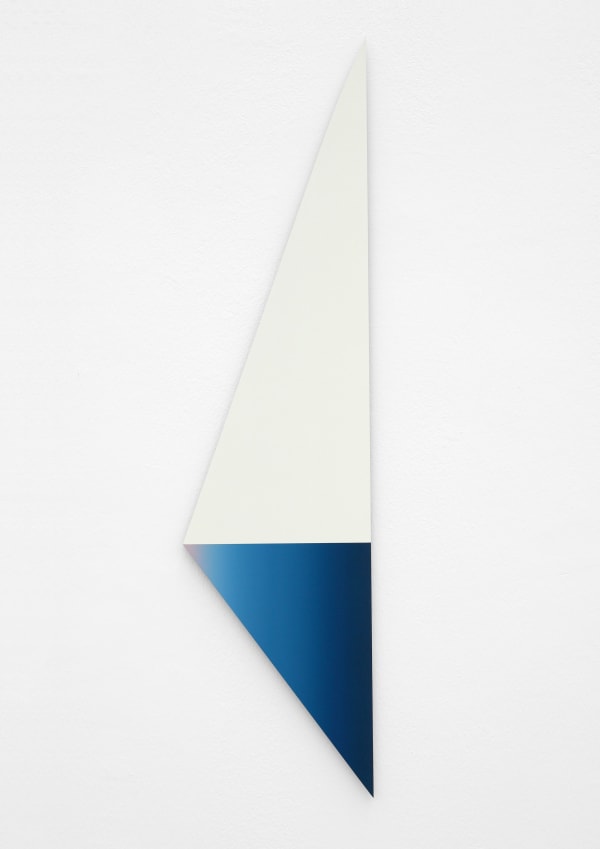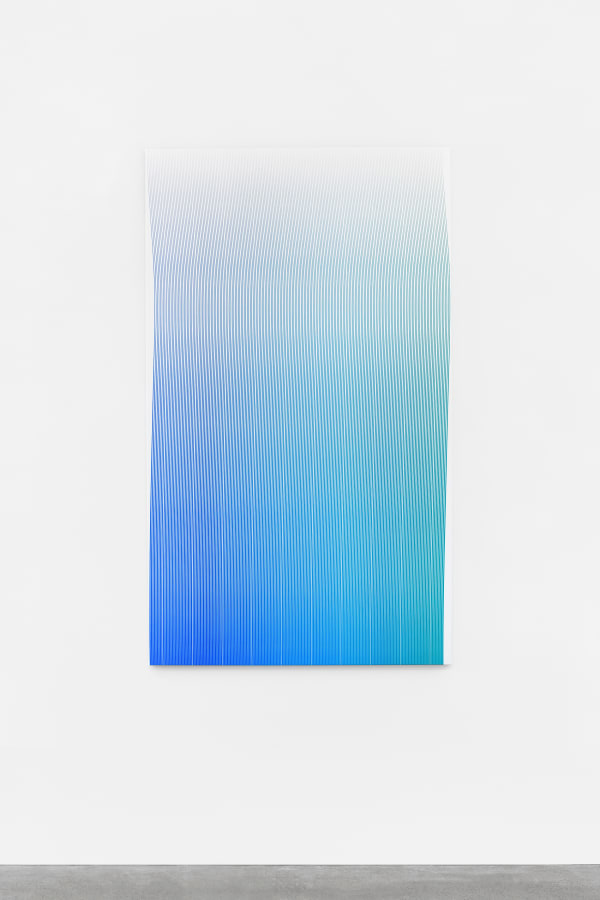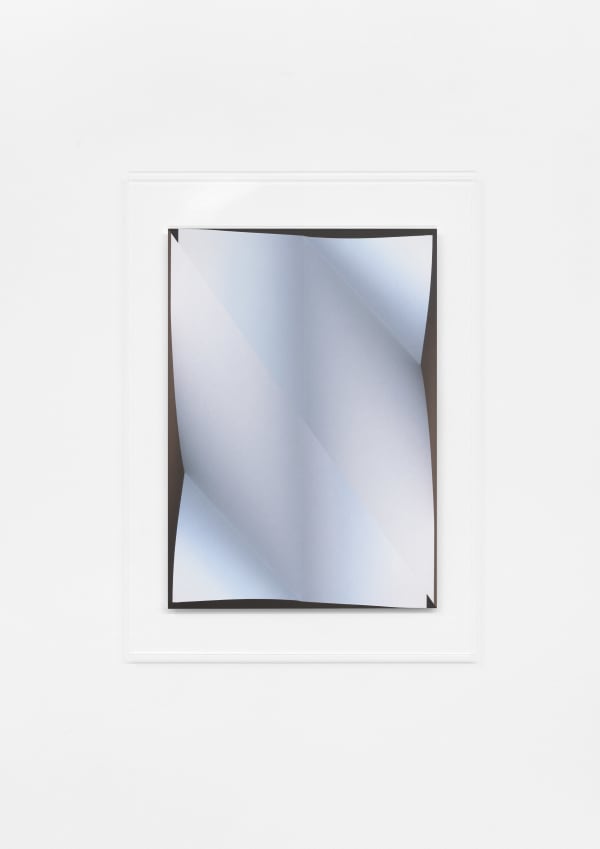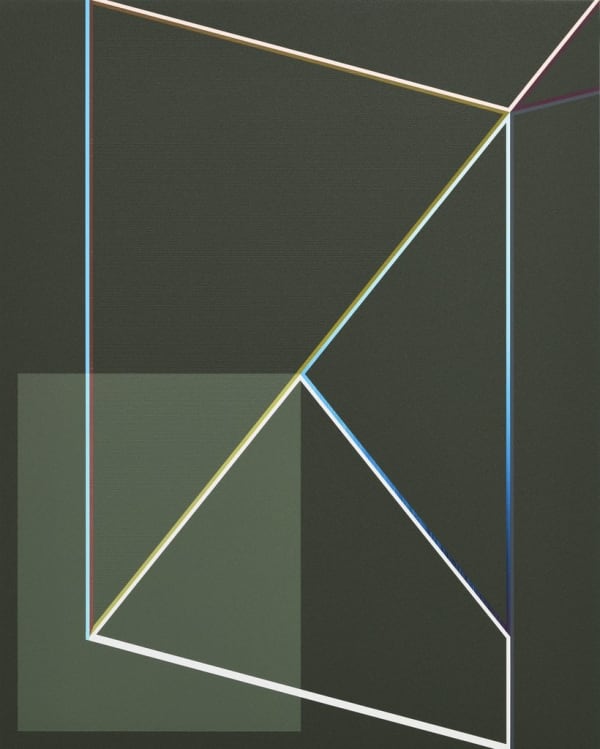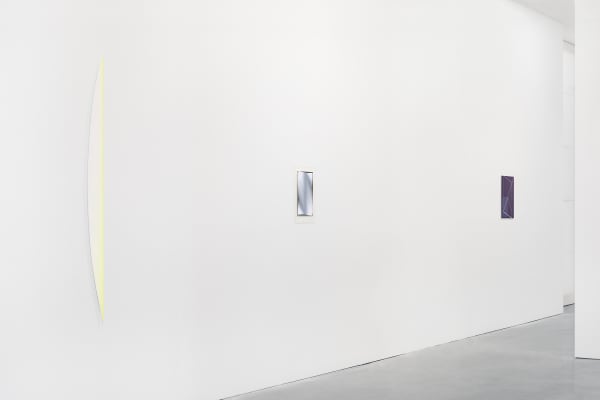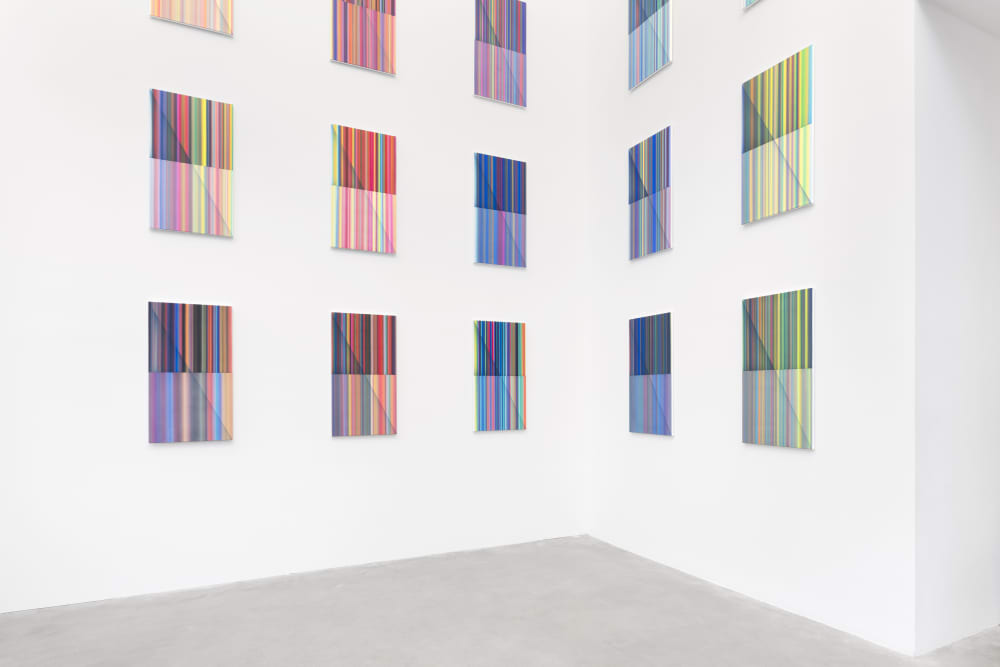UNIT: JONAS WEICHSEL
-
介绍
Jonas Weichsel presents in his exhibition Unit new works elaborating on his distinctive painting technique; including meticulously composed gradient paintings. Through the interplay of mechanical precision and the emotive ability of color, the works oscillate between definitude and haziness, material presence and dissolution. Here, Weichsel continues his ongoing pursuit—extending the possibilities of an autonomous painterly language, in dialogue with the media and aesthetics of the digital age.
At first glance, the works of Jonas Weichsel appear minimal, pared down to basic geometric elements and a readily discernible color palette. In many, the medium may not be immediately recognizable as painting—or painterly, even; instead displaying a cool detachment and mechanical touch. Stark linearity, grids, and gradients fill geometric, at times irregular, planes, lending the overall impression of digitally produced renderings.
But while digital technologies have been an ongoing point of fascination for Weichsel, they are not his main operational mode. Rather, the questions central to Weichsel’s practice concern the nature of images, what they are and can be—what painting can be—in an increasingly digital world. This manifests in his work through a slowed down, precise, and highly specialized approach. It is an approach that gives images dedicated space and time to develop—a counterpoint to the ever-growing mass of visual stimuli that floods our screens at a rapid pace each day. In Unit, Weichsel’s first solo exhibition at Galerie Thomas Schulte, the artist continues to elaborate on this distinctive painting technique that combines hand-painting and traditional means with digital modes and specialized instruments, developing new directions and lines of inquiry in the process.
Seeking to extend the possibilities of an autonomous painterly language, Weichsel’s works nonetheless retain a conscious dialogue with digital media, processes, and aesthetics. This does not only manifest through his use of digital techniques, but in more indirect ways as well. The luminosity of screens, for example—the changes in perception that occur between shifts in angle, lighting, and our own proximity—is also similarly manufactured by Weichsel’s layered, translucent, and quietly complex images.
However, his images are not devices of pure optical illusion. Rather, Weichsel’s works are more concerned with an embodied experience of the image. This is generated via calculated interplays of line, color, layered transparencies, and semi-transparencies that induce haptic effects, in tandem with the emotive, expressive ability of color. Here, Weichsel’s otherwise highly analytical approach to painting is countered by an underlying emotional impetus. It manifests through the subjective impact a particular color or color combination, contrast or method of application, can produce—whether in the process of its creation, or when experienced by the viewer.
Finne (2019) materializes the color-change process via a paint application method described simply as ‘shimmering colors’. Juxtaposing yellow and semi-transparent purple pigment, the relationship between the complementary colors—defined as the strongest form of contrast—becomes nearly imperceptible from certain angles. But the structure’s paperlike, smooth polyester surface, folded and gently curved, encourages changes in position and a closer look, which brings its shifting color intensities into view. The work represents a new development in Weichsel’s practice; and emphasizes the atmospheric effects that the artist is particularly engaged with at present.
In a similar structural approach, Rekord (2020), a blank sheet of paper is scanned and printed onto aluminum—a flat surface made sculptural, flattened again, and transferred to another, smoother surface. It is an imperfectly scanned reproduction of a non-image: hazy, uneven, creased down the middle. It is inherently digital; yet it does not lose the tactility of the original. The preserved sense of tactility, perhaps, lies in the gesture—the fold down the middle—which leaves a trace of material interaction, alluding to its malleability.
This tension is present throughout Unit, and in Weichsel’s work more broadly—between flat surface and sculptural object, closeness and distance, material presence and dissolution. It manifests in a similar way via the flag motif, which emerges in title, as well as form, in works like United Europe Flag (A) (2019), a gradational silkscreen print on canvas. Its rectangular form slightly curved and wavering, an uneven white border becomes visible at the edges, evocative of subtle motions induced by a light breeze—the rippling of a flag in the wind. In this way, the surface is not perceived as rigid, immobile, or uninfluenced by atmospheric conditions. It allows for a degree of flexibility in otherwise straightforward geometrical forms, while hinting towards an interdependence between image, physical position, and external factors.
Moving further along this line, the exhibition features Cloud Painting, a new gradient painting, which takes on an initially blurred appearance. Remarking on its relative lack of transparency and seemingly diffuse, unstructured surface, Weichsel describes it as ‘cloudy’. However, its cloudiness is an illusion that dissipates once its defined surface comes into view. With transparent layers of color meticulously applied through a process of taping down foils and spraying paints, Weichsel produces smooth color transitions from a wide array of shades. The position-dependent color units come together to form a larger, more digestible whole. Only to reveal, upon closer inspection, an intricate matrix of sharp contrasts. With its inner workings exposed, the initial impression of softness and comfort gives way to something more challenging, perhaps even jarring. Akin to the pixels that make up images on our screens, there are so many more colors present than are immediately visible to the naked eye.
Unlike digital images, however, Weichsel’s are not intended for screen-based consumption. Their mode of communication is more direct, mediated only by a fluctuating, haptic boundary—produced by their own dynamic, layered surfaces. In this way, the physical experience of producing and viewing images, and painting in particular, is initially subverted and then illuminated. At a time in which the way we connect with art, images, each other, and ourselves has become increasingly mediated by screens and digital media, Weichsel’s works explore an alternative. It is not a complete departure, but rather a questioning of what painting can become in this context; slowly, though continually, evolving and expanding, while remaining, intrinsically, painting.
—Text by Julianne Cordray -
作品
-
安装图示
-
Inquire about works by Jonas Weichsel

-
视频
-
参展艺术家


